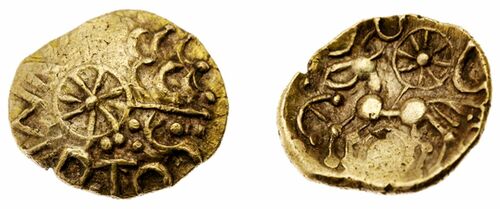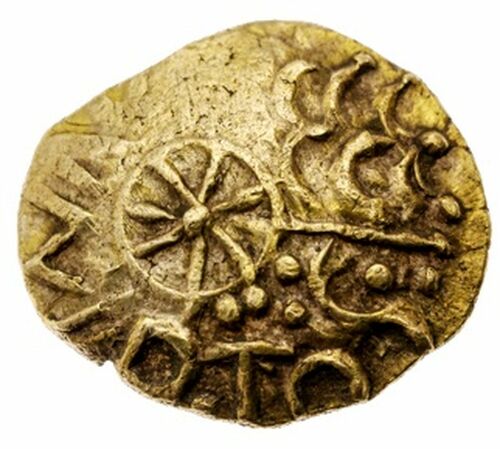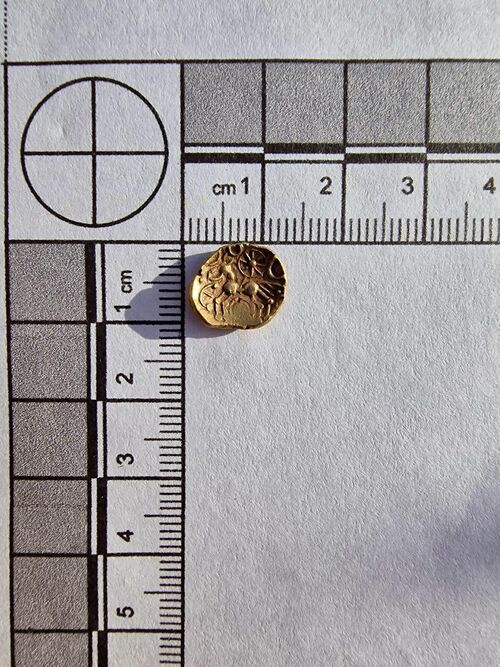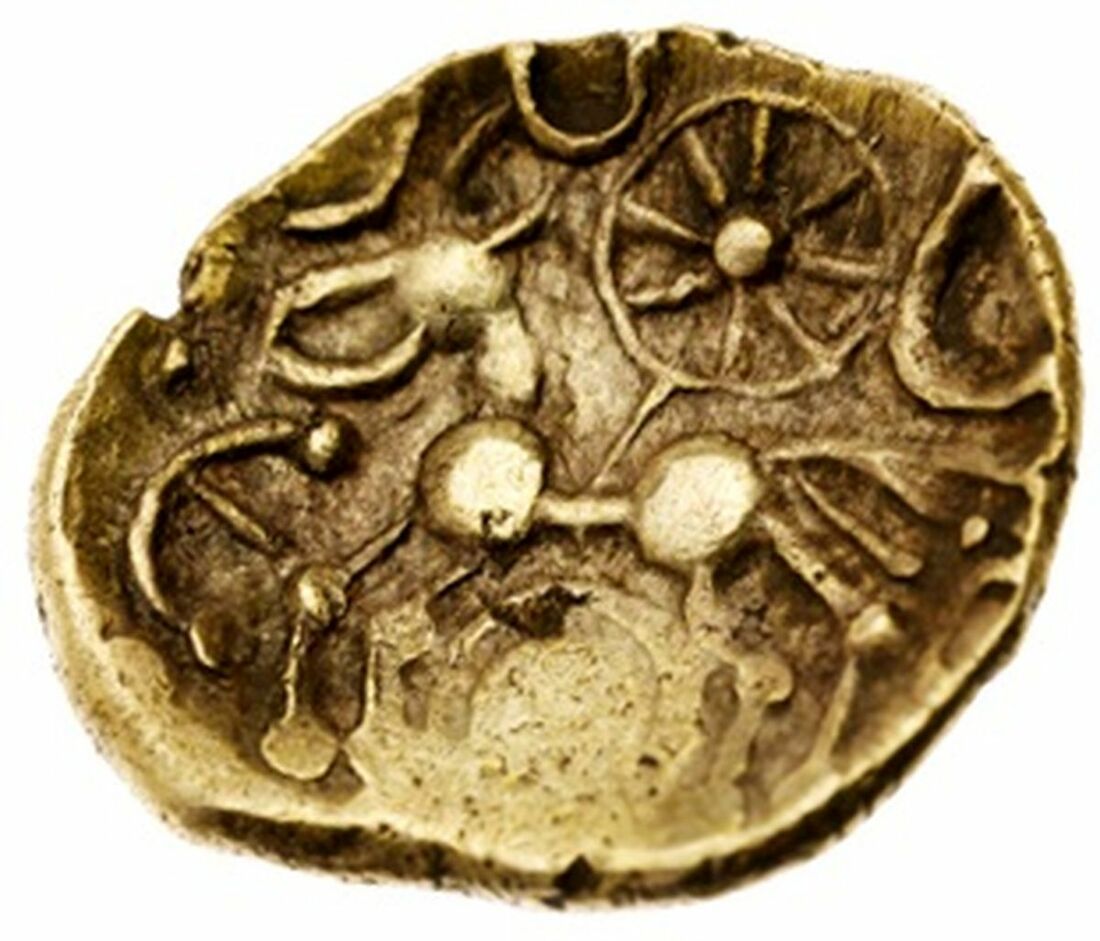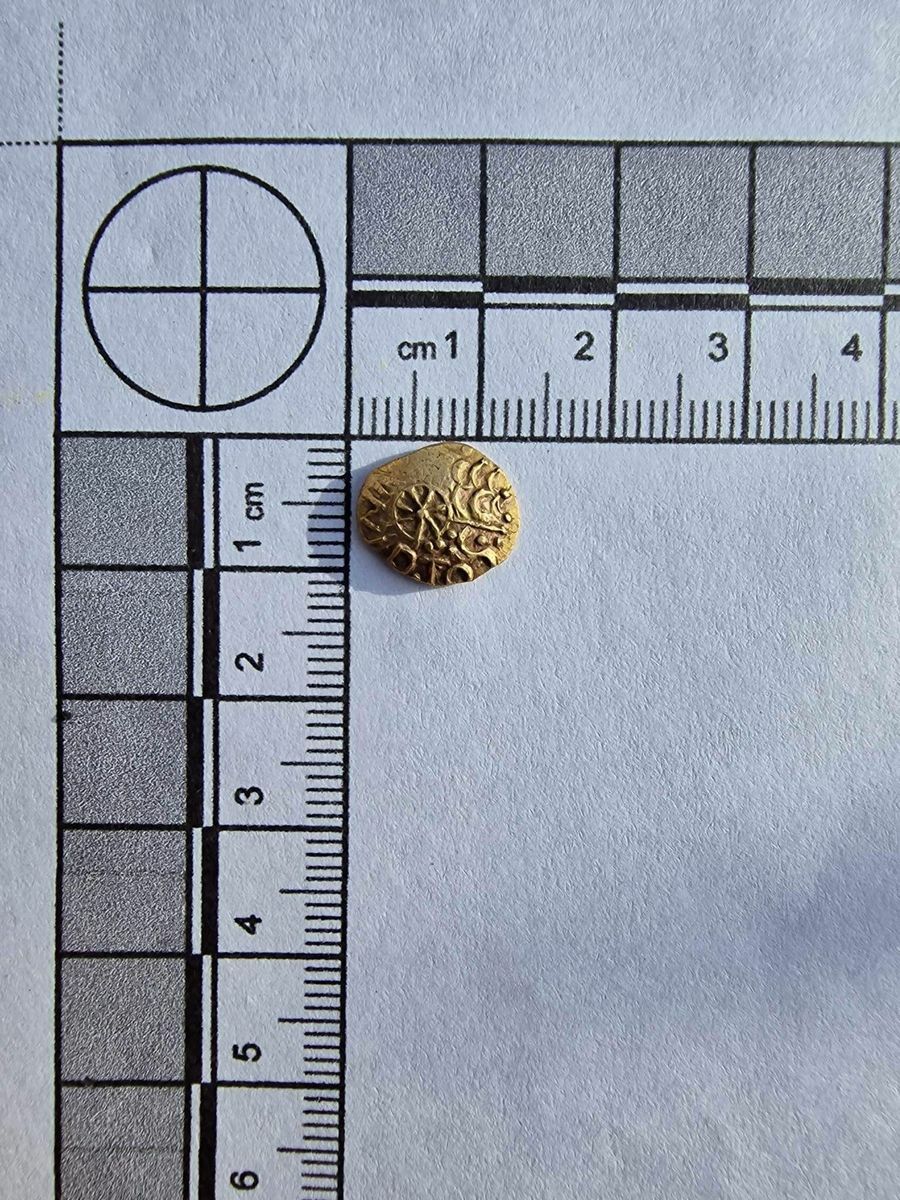Auction: 23006 - The Official COINEX Auction at Spink
Lot: 26
A NEW IRON AGE "KING" | Iron Age Britain, Belgae, "Esunertos" (c. 50-30 BC), AV Quarter-Stater, debased laureate head of Apollo right [?], formed of three interlocking rows of outward facing crescents, a seven-spoked wheel at centre in lieu of ear, eye of visage with radiating spike towards neck line, [IIS]VNIRTOS commencing at 1 o'clock and running outwards behind head, pellet motives above and around, rev. tripled-tailed annulate horse left with pincer-like mandible for face and linear ear, with pelleted mane, yoke or bucranium [?] above head, 8-spoked wheel above spearing back, and double or triple [?] ringed annulet below, pelleted-E motif before forepart, unclear circular linear motif above tail, [Median Spink XRF: ~ 48.21% Au; ~ 29.66% Ag; ~ 21.59% Cu; ~ 0.54% Fe], 12.65mm x 11.75mm x 2.65mm., 1.197g [18.47grns], 8h (CCI 23.0084 this coin; cf. Hants Cultural Trust Entry Form H4223 = PAS HAMP-9E612E; VA -; BMC -; ABC -; Spink -, but 2023 RCM 'Find of the Year' Winner), an area of partial striking softness below wheel and in corresponding area of reverse below horse, otherwise an exquisitely clear legend reading, one of the earliest instances of an inscription to be found on a native British coin, and a previously unknown "ruler" and undoubted contemporary of Caesar's client King Commios, and of reddish-gold fabric scientifically confirmed to be of a consistent metallurgical standard, on an irregular but full-weight flan, a really good very fine, EXCESSIVELY RARE and of great significance towards our understanding of the dissemination of classical language amongst tribal elites and dispossessed Gallic settlers in the century before the successful Claudian invasion of Britannia
Provenance
Found in the Test Valley (Hampshire), 12 March 2023
~ Recorded with the Ashmolean Museum, ref. CCI 23.0084 ~
~ Recorded with the British Museum, ref. PAS - ????~
Spink XRF Analysis (Conducted 1 September 2023, Olympus VANTA Series L, from which the median reading is calculated):
Reading 1 (Obverse), 10 seconds:
Au - 49.24 (+/- 0.52)
Ag - 28.96 (+/- 0.37)
Cu - 21.40 (+/- 0.42)
Fe - 0.40 (+/- 0.15)
Reading 2 (Reverse), 10 seconds:
Au - 47.18 (+/- 0.51)
Ag - 30.36 (+/- 0.38)
Cu - 21.78 (+/- 0.42)
Fe - 0.68 (+/- 0.17)
In 1996, the discovery of the Alton ('East Meon') Hoard finally answered a conundrum that had plagued the Iron Age British coin series for centuries - was it Tincommius or Tincomarus? This enlightening discovery finally confirmed the name of an Atrebatic son of Commius, who had been himself appointed to rule by Julius Caesar. Ultimately this confusion had descended from an inaccurate reconstruction of Augustus' Res Gestae and the hitherto incomplete TINC or TINC COM F legend readings from known surviving coins. Prior to this cataloguer joining Spink, he had elected to take on, as John Creighton had before him, the complicated evolution of uninscribed to inscribed coinage in the context of the book-end invasions of Julius Caesar and Emperor Claudius. The ambit was simple - explain how language and culture pre-conditioned Iron Age Britain for life after AD 43. Most revisionist historians simply omit study of the Celtic coinage on account of its specialist idiosyncracies, despite its clear value both from the native written and visual perspective, but more crucially in the precise dating to which each numismatic article can be attributed.
Today we are faced with a similar scenario, albeit in the slightly more alarming circumstance of a previously uninscribed issue suddenly transpiring to be an exceedingly early inscribed coin. As John Sills (pers comms.) writes: "The recognition of three coins of Esunertos, a hitherto unknown Iron Age ruler, is one of the outstanding discoveries of recent decades in Celtic numismatics. David Robinson, an Iron Age specialist, and Gregory Edmund of Spink both forwarded this quarter stater to me on the same day. Although I was initially sceptical, Philip de Jersey immediately realized it was genuine, and later that day David sent details of another quarter stater from different dies recorded by the Portable Antiquities Scheme in 2014. It had been assumed to be uninscribed because almost all the name was off the flan, but with the new coin in hand it became clear that the upper parts of several letters were visible. A few days later Gregory, after diligent searching in Spink's archives, located a silver unit from a third pair of dies that had lain unrecognized for many years, found at Ashley Wood Camp, Hampshire. Combining the three coins allows us to reconstruct the full name, which appears to have been engraved as IISVNIIRTOS with E shown as II, as on some staters of Dubnovellaunos in Essex (e.g. ABC 2392), and the coinage of the Corieltavian ruler Esuprasu. If so, this represents by far the earliest attested example of an elite aristocratic name, "Mighty as [the god] Esos" previously only known as Latinized Esunertus on three much later inscriptions in Roman Gaul and Upper Germany. Miraculously, all three coins are not only provenanced but come from three different Hampshire sites north-west of Winchester, around the upper reaches of the river Test. Within this triangle is the famous Iron Age hillfort of Danebury, excavated between 1969 and 1988 by Professor Barry Cunliffe.
There are no exact parallels for the overall type, but the anepigraphic Tadley Wheel quarters also have a large wheel at the centre of the obverse and another above the horse on the reverse (Divided Kingdoms, p. 209, no. 287). They are found in the same general area and may be related, although they are the work of a different hand. The Esunertos type belongs to a large group of local issues scattered across central southern England, although the only one with any trace of a name is the mysterious Ex Head unit, ABC 995. Precise dating is not possible, but the majority of local issues can be assigned to the period between the late 50s and early 30s BC when Commios was in the process of establishing his authority over the region. Many of these often tiny coinages seem to have been struck by émigré groups who had fled Gaul in the wake of Caesar's invasion. The presence of many hundreds, perhaps thousands, of battle-hardened Gaulish warriors in Hampshire and West Sussex goes a long way to explaining why Commios, himself an exile, settled in this part of the country. The relatively small area controlled by Esunertos overlaps with the western edge of Commios's gold (DK, p. 327, map 46) but beyond this we cannot know what his relationship, if any, was with the Belgic warlord. Had he been one of his lieutenants in Gaul, allowed by dint of service to add his name to the coinage? Was he a local usurper, a rival to Commios who briefly controlled this corner of Hampshire? Was he, in effect, the last king of Danebury, the only one whose name we will ever know? The hillfort was in decline by the first century BC but could well have been reoccupied by Gaulish migrants. Whoever he was, Esunertos was determined that everyone should know his name, and in that he succeeded."
Spink wishes to thank Dr John Sills and Dr Daphne Nash Briggs in particular for their inspired work on interpreting this forgotten ruler; elder; chieftain; or possibly even usurper previously lost to the mists of time.
Subject to 20% VAT on Buyer’s Premium. For more information please view Terms and Conditions for Buyers.
Sold for
£17,000
Starting price
£3500

